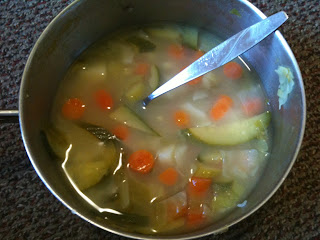Chocolate Chip Pumpkin Bread
1.5 cups all purpose flour (replaced all flour with white whole wheat flour)
1.25 cups whole wheat flour
1 tsp. baking powder
3/4 tsp. baking soda
1/2 tsp. salt
1 tbsp. cinnamon (would increase this to 1.5 tbsp)
1/8 tsp. nutmeg (would increase this to 1/4 tsp)
1/8 tsp. ground cloves (didn't have this)
1 cup canned pumpkin (oops - I used a whole can and it turned out fine!)
2 large eggs
1/2 cup veggie oil (1/3 cup oil and a few tablespoons of applesauce)
3/4 cup sugar (1/3 cup sugar)
handful of chocolate chips
Preheat oven to 375 F. Grease 1 8.5" loaf pan. Sift together flour, baking powder, soda, salt, spices. In another bowel, combine pumpkin, sugar, eggs, oil. Add dry ingredients to pumpkin mixture and gently stir together until combined. Fold in as chocolate chips. Pour and scrape mixture into prepared pan and smooth top. Bake ~40 minutes (check at 30 minutes). Allow to cool before slicing.
The mixture is pretty thick. Next time, I may experiment with adding half a cup of yogurt to make this bread more moist (although I overbaked it at 45 minutes), but I think it's delicious as is. Without the whole wheat flour, I doubt you'd need the yogurt.





